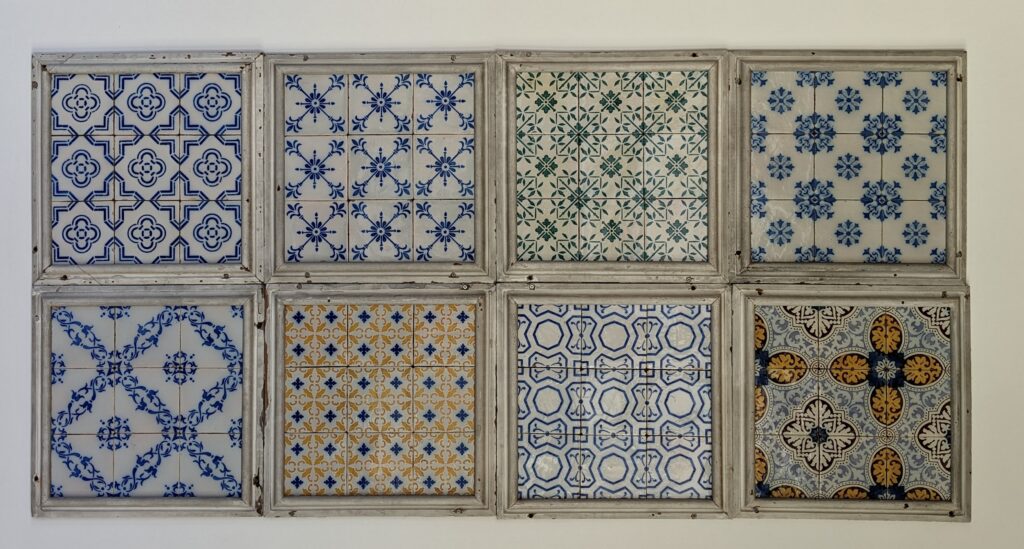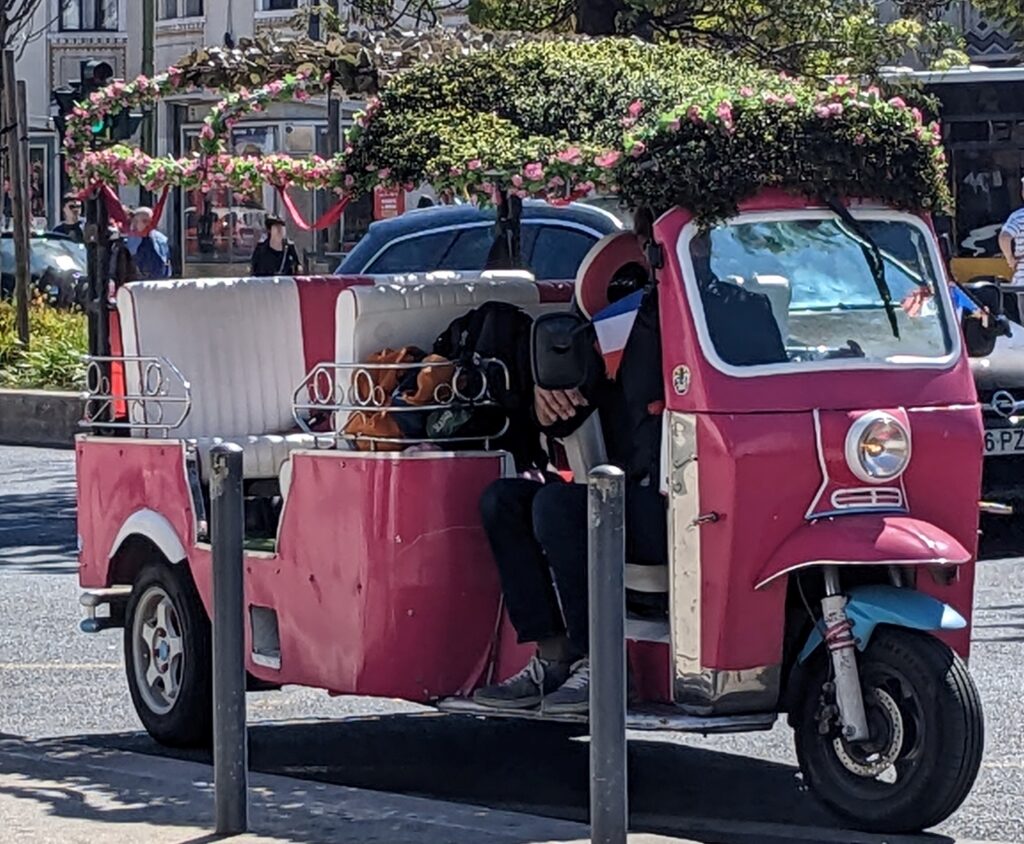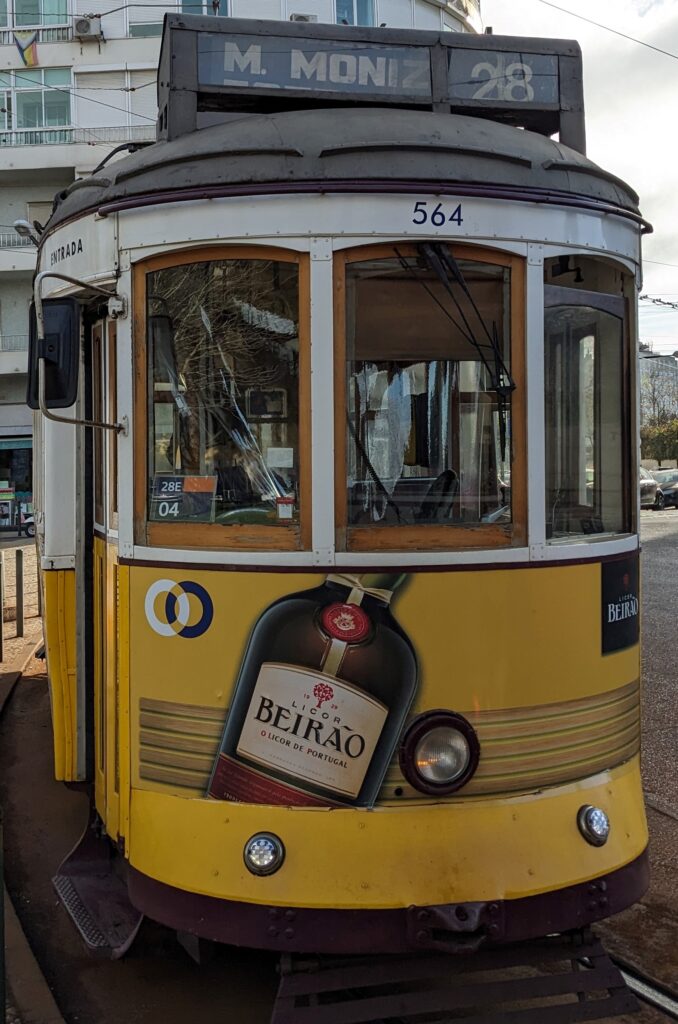
Three wonderful weeks in Portugal, and a common theme or two has begun to emerge. We have spent our time very merrily in Porto and Lisbon. Both towns are densely populated with people and churches, and incredibly steep. There are more level parts, but generally, a walk through either city involves an awful lot of hill climbing and steep descents. Thus, with my limited fitness for mountaineering, we quickly came to recognize the benefits of public transport. One of my favourite occupations was picking out the almost endless variety of patterned tiles or azulejos that have been used to decorate paths and plazas, walls and floors, on churches, monasteries, palaces, houses – inside and out – and even railway stations all over both cities. And of course, there were coffees and Portuguese tarts available whenever a particularly strenuous uphill climb required a breather…
The famous tiles of the Iberian Peninsula have been influenced by artistic styles from several different countries, and ‘indigenized’ by the Portuguese and Spanish artists. ‘Azulejos’ first appeared in Portugal in the 15th Century, courtesy of the Moors from North Africa. The word azulejos is Arabic in origin and comes from az-zulayj and I’ll leave it to you to imagine how that should be pronounced. It roughly translates as “polished stone” and I have fantasized about using them to decorate the kitchen, the patio, and the bathroom at home, but fear they would not travel well in my suitcase. Much to the One & Only’s relief. Nonetheless, we have had a wonderful time noting the different colours and patterns as we wander through the cobbled streets of Porto and Lisbon. We even found a museum in Lisbon to give us some background to their history.
The National Tile Museum (Museu Nacional do Azulejo) was established in 1965, in the former convent of Madre Deus. It was a long walk from our apartment, but worth every step. The museum collection features decorative ceramic tiles from 1450 to the present-day. Prominent across the Iberian peninsula since the Moorish invasion in the 13th century, such tiles soon became an integral part of Portuguese and Spanish culture. During the 16th century, the Portuguese developed their own motifs to add to the Arabic ones, often taking their ideas from nature. In the 17th century, a Spanish artist introduced the blue-and-white tiles from the Netherlands. Large tiles painted with historical or biblical scenes in blue and white were adopted by Portuguese artists. The Portuguese nobility particularly liked hunting scenes and satirical scenes from mythology.
In the Monastery of São Vicente de Fora, during the early 18th century, King João V commissioned tile paintings from ‘Grand Master‘ Manuel dos Santos, who covered the walls and staircases all over the monastery with blue and white tiled pictures of biblical and historical scenes. One exhibition even contains a unique collection of Jean de la Fontaine’s fables depicted in Portuguese tiles. The room that most appealed, however, was not decorated with tiles, but with polychromatic inlaid marble. The sacristy, a glorified changing room for the priests, is still used today and is totally enveloped in wondrous marble designs, with inlaid jacaranda wood chests to hold the vestments, and a beautiful painted ceiling.
“More is more” appears to have been the order of the day, particularly remarkable in the incredibly ornate Monastery of St. Jerónimo in Belém, one of the first monuments in Europe to be listed as a World Heritage Site. Built in the 1500s with profits from the spice trade, it was home to the monks of the Order of Saint Jerome, and is described as a ‘masterpiece of Manueline architecture… [that] glorifies the Age of Discovery, Portugal’s power at sea, and its contact with distant lands.’
Legend has it that the original Portuguese tarts, or pastéis de nata (literally cream pastries) were created by those same Jerónimo monks in Belém just west of Lisbon. Apparently, the monks would use vast quantities of egg white to starch their religious habits and vestments. They would then use the leftover egg yolks to make cakes and pastries. The monks original pastel de nata recipe is supposedly around three hundred years old.
When the monastery was shut down after the Liberal Revolution of 1820, the recipe for pastel de nata was sold to Pastéis de Belém, a local, family-owned bakery that has continued baking them to the original recipe ever since. A recipe which is known to only a select few, a trade secret.
These days, variations of Portugal’s iconic custard tarts, once a local speciality, can be found all over the world. I have eaten Portuguese tarts in Geelong, in Luxembourg, in Prague, by the Torrens in Adelaide, in Macau. Recently, I have munched on several (not all at once) in Porto, served with a jar of cinnamon to sprinkle on top, which is apparently a traditional flourish I had not encountered elsewhere. I’m not sure whether the one in front of me is authentic, but I am sitting outside the Monastery as I write, so it stands a better chance than most. Whatever it’s origins, this flaky nest of golden pastry filled with blistered, caramelized custard is a morsel of sweetness and light, crispness and creaminess that goes beautifully with a strong black coffee.
******
For the past three weeks in Portugal, we have mostly got about on foot. But when the going gets tough, which it frequently does in both Porto and Lisbon, there are alternative options. Porto has a cable car on the south side of the river that drops gently down from Santa Marinha to Vila Nova de Gaia, and a funicular on the north side, opposite the lower end of Dom Luis I Bridge. But both these options still require a significant climb at one end. So, for me, the better option was a tuk-tuk or a tram, when my legs were feeling feeble. The tuk-tuk drivers generally prefer to take you on an (expensive) private tour of the city, so they are not always the best way to get from A to B. On the other hand, they appear on every corner, particularly in Lisbon.
Tuk-tuks are usually associated with the densely packed and congested cities of Asia, Bangkok in particular. The name certainly came from the Thais, who named these three-wheeler, motorized taxis ‘tuk-tuk’ for the onomatopoeic sound of its two-stroke lawnmower engine. However, there are claims that these three wheeler taxis emerged first in Japan, or perhaps Italy, just before, or just after WWII. Since then, whoever invented them first, they have spread like a plague all over the globe. Now they in any busy city where there are tourists.
I have used tuk-tuks in India, Nepal, the Philippines and Thailand, but am yet to board the Portuguese variety, but we have admired them cruising round Lisbon, often decorated with plastic flowers and greenery. While they are inclined to sneak up behind pedestrians with their whispering new electric engines, we have so far avoided being bowled over, thank goodness.
We have, however, used the appealing and elderly trams, in both cities. In particular, we have loved boarding the 28E which sails past the end of our street in Lisbon every few minutes. Like Harry Potter’s night bus, it lurches up the almost horizontal hills, and barrels down the other side like a runaway train, screeching to a halt for passengers to board and disembark, and somehow skimming past the cars that park dangerously close to the tramlines, despite the risk to life and limb and wing mirrors. The Lisbon tramlines have been in operation since 1873. Originally, the wooden carriages were pulled by horses along the lower, flatter levels of the city. In 1901, the trams were electrified, which meant they could manage the hills too. Buses and metros may have usurped the tram network in the 21st century, but the six remaining tramlines in Lisbon are still a popular tourist attraction. Much of the rolling stock has been modernized, but the heritage yellow trams can still be found on some routes.
And so we say farewell to Portugal, and board a plane heading south for Marrakesh. And finally, some really warm weather…
*Thanks to Google images for the pic of the Portuguese tarts, as I was too busy munching to take photos! The rest were taken either by me or the One & Only!




